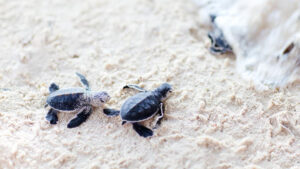Each spring and summer, sea turtles, shorebirds and seabirds nest on our local beaches. Because our shorelines are critical for sea turtle and waterbird nesting, beachgoers can make a big difference in helping them.
 Our area had a successful green sea turtle nest hatch early in the morning on October 19, 2021! Out of 93 eggs, 90 of them hatched, giving the nest a 96.8% hatch success. In November 2021, Coastal Resources and Gulfarium staff released 12 sea turtle hatchlings (6 loggerhead, 6 green) 50 miles offshore in the Gulf of Mexico.
Our area had a successful green sea turtle nest hatch early in the morning on October 19, 2021! Out of 93 eggs, 90 of them hatched, giving the nest a 96.8% hatch success. In November 2021, Coastal Resources and Gulfarium staff released 12 sea turtle hatchlings (6 loggerhead, 6 green) 50 miles offshore in the Gulf of Mexico.
Destin-Fort Walton Beach and the Gulfarium are partnering to host educational turtle talks. The talks take guests on a behind-the-scenes tour of the Gulfarium’s C.A.R.E. Center to share information about sea turtle nesting habits and demonstrate a mock intake of an injured sea turtle. For additional information, visit destinfwb.com/explore/ecotourism-hotspots/turtles.
Keep your distance! Getting too close (50 feet or less) to nesting sea turtles can cause them to leave the beach before they complete nesting. Remember, it is illegal to harm or disturb nesting sea turtles and their nests, eggs and hatchlings. Not keeping enough space from nesting shorebirds, seabirds and wading birds can cause them to flush from their breeding sites, leaving vulnerable eggs and chicks exposed to the elements and predators. Egg temperatures can increase to lethal levels after just a few minutes of direct sun exposure. Shorebirds and seabirds nest in shallow scrapes in the sand and their eggs and chicks are well-camouflaged, making them vulnerable to being stepped on unless people look out for them and avoid walking though flocks of birds. As a general rule, it is best to keep at least 300 feet from nesting birds and to avoid walking through flocks of birds or entering posted areas.
Stash the trash! Obstacles on the beach can prevent sea turtles from nesting as they crawl from the water, across the sand, to lay their eggs. Trash and other obstacles can also prevent sea turtle hatchlings from reaching the water once they emerge from their nests. Food scraps attract predators, such as raccoons and crows, that can prey on sea turtle hatchlings, shorebird eggs and chicks. Litter on beaches can entangle sea turtles, birds and other wildlife. Beachgoers can help our native wildlife by properly disposing of all trash, filling in human-made holes in the sand, and removing boats, beach toys and furniture from the beach before sunset. Fishing line can be deadly to sea turtles, waterbirds and other wildlife, so be sure to dispose of it properly. To find a monofilament recycling station near you, visit mrrp.MyFWC.com.
Lights out! Any lighting can misdirect and disturb nesting sea turtles and their hatchlings, leading them away from the ocean and toward potential danger, so beachgoers should avoid using flashlights or cellphones on the beach at night. Anyone living along or visiting Florida beaches can do their part by turning out lights or closing curtains after dark to ensure nesting turtles are not disturbed as they come ashore, and hatchlings will not become disoriented when they emerge from their nests. If lighting could still be visible from the beach, be sure it is long, low and shielded.
For more information about nesting sea turtles and how you can help, visit MyFWC.com/SeaTurtle. Other ways to help sea turtles include reporting those that are sick, injured, entangled or dead to the FWC’s Wildlife Alert Hotline at 888-404-FWCC (3922).
The post It’s Turtle and Shorebird Nesting Season! appeared first on South Walton Life | 30A News, Events and Community Information.

Be the first to comment on "It’s Turtle and Shorebird Nesting Season!"